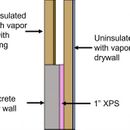Pony Wall Insulation Strategy
Hello GBA community,
I’m struggling to determine the best approach to increase the insulation in my basement and wondering if this forum might have some suggestions.
I’m in climate zone 6 (eastern Canada) and have a split-level house. The exterior wall of the basement is composed of a 4′ concrete pony wall with 2×4 framing on top filled with fiberglass batts and covered with a vapor barrier followed by hardboard paneling. Previous owners then finished the basement by insulating the interior of the concrete wall with 1″ of XPS and then erecting a 2×4 stud wall floor-to-ceiling. The study wall is finished with a vapor barrier and drywall.
I was hoping to cut a few access holes to add Rockwool batts into the lower portion of the empty 2×4 wall and then fill the cavity between the two walls with fiberglass, but given the number of vapor barriers in this assembly is there a strategy that makes sense?
Thanks in advance!
GBA Detail Library
A collection of one thousand construction details organized by climate and house part










Replies
Where is grade in relation to the basement wall? Is any section of the framed wall below grade? Generally vapour barriers should be installed in contact with the warm side of the insulation so as to not create a condensing surface.
The assembly above does have 2 vapour barriers with a cavity in between, which is not good. Have you opened it up and checked for moisture?
Grade is about 10-12" below the top of the concrete wall. The top of the interior wall is behind a drop ceiling so I have been able to take photos down the stud bays and have seen no moisture issues inside.
If you are not dealing with moisture issues now that is great, but I would not hazard a guess about performance after modifying this already non typical assembly. Maybe somebody else has a more informed opinion?